|
Printables |
PowerPoints |
Online exercises |
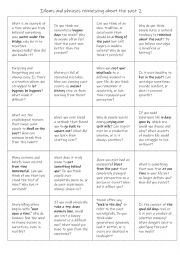
|
Idioms and phrases reminiscing about the past 2
This is a speaking reinforcement activity to supplement the other worksheet. Students working in pairs or small groups can either ask each other the questions or answer the question themselves.
Level: intermediate
Age: 12-100
Type:
Downloads: 118
|
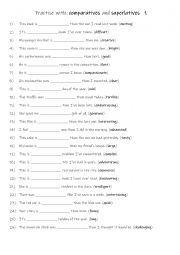
|
A1+-A2 Practise with comparatives and superlatives 1
Students should learn comparatives and superlatives as they are essential for effective communication, allowing them to describe differences and extremes clearly. These structures enhance critical thinking by enabling comparison and evaluation, which are vital for forming opinions and writing arguments. Additionally, they are frequently used in eve...
Level: elementary
Age: 8-100
Type:
Downloads: 120
|
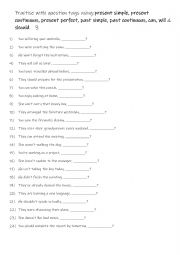
|
A2+-B1 Practise with question tags using present simple, present continuous, present perfect, past simple, past continuous, can, will & should. 3
Students familiarise themselves with the tenses and modal verbs, then they read the sentences to work out which one is needed to complete the gap-fill. Answers on page 2.
Level: intermediate
Age: 9-100
Type:
Downloads: 123
|
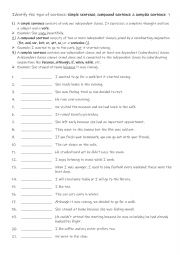
|
A2 Identify the 3 types of sentences: simple sentence, compound sentence & complex sentence 1
First, students need to familiarise themselves with the 3 types of sentences and their use. Then they read the sentences and identify which types they are. Each type is used 7 times! Answers on page 2.
Level: elementary
Age: 10-100
Type:
Downloads: 114
|
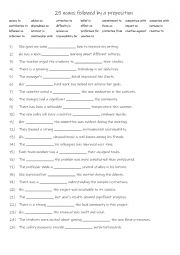
|
B1-B2 25 nouns followed by a preposition
Understanding how to pair nouns with the correct prepositions helps convey ideas more clearly, reducing ambiguity. Many phrases in English are idiomatic; knowing these combinations allows students to speak and write more naturally, as native speakers do. Many of these nouns are relevant in everyday conversations and discussions, making this knowled...
Level: intermediate
Age: 9-100
Type:
Downloads: 107
|
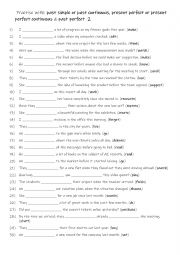
|
A2+-B1 Practise with past simple or past continuous, present perfect or present perfect continuous & past perfect 2
Students should practise past simple, past continuous, present perfect, present perfect continuous, and past perfect to communicate more precisely about different timeframes, actions, and experiences. These tenses help in narrating events, linking the past with the present, and describing ongoing actions. They improve fluency, enable clearer conver...
Level: intermediate
Age: 9-100
Type:
Downloads: 120
|
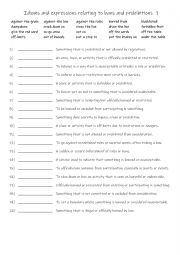
|
B1+-C1 Idioms and expressions relating to bans and prohibitions 1
First, students need to familiarise themselves with the 20 idioms and expressions and their meanings. Then they read the definitions to see which one is being described and write that word in the space provided Answers on page 2.
Level: intermediate
Age: 12-100
Type:
Downloads: 112
|
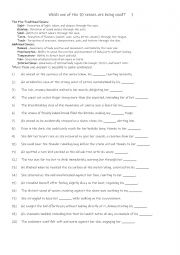
|
Which one of the 10 senses is being used 1
Learning about the traditional and additional senses helps students understand how humans perceive and interact with the world. It highlights how senses like sight, hearing, smell, taste, and touch, along with balance, proprioception, and temperature, provide essential information for navigating and responding to our environment. This knowledge is ...
Level: elementary
Age: 9-100
Type:
Downloads: 118
|
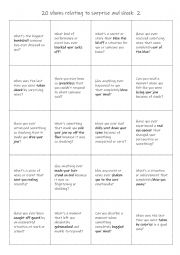
|
B1+-C1 20 Idioms relating to surprise and shock 2
This is a speaking reinforcement activity to supplement the other worksheet I uploaded on 3/2/2025. Students working in pairs or small groups can either ask each other the questions or answer the question themselves.
Level: intermediate
Age: 11-100
Type:
Downloads: 118
|
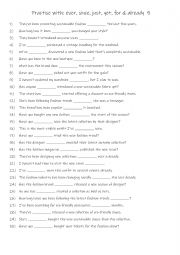
|
A2+-B1 Practise with ever, since, just, yet, for & already 5
First, students need to familiarise themselves with the 6 adverbs and their use. Then they read the sentences to work out which one is needed to complete the gap-fill. Each adverb is used 5 times! Answers on page 2.
Level: elementary
Age: 7-100
Type:
Downloads: 133
|
|
|
|
|












